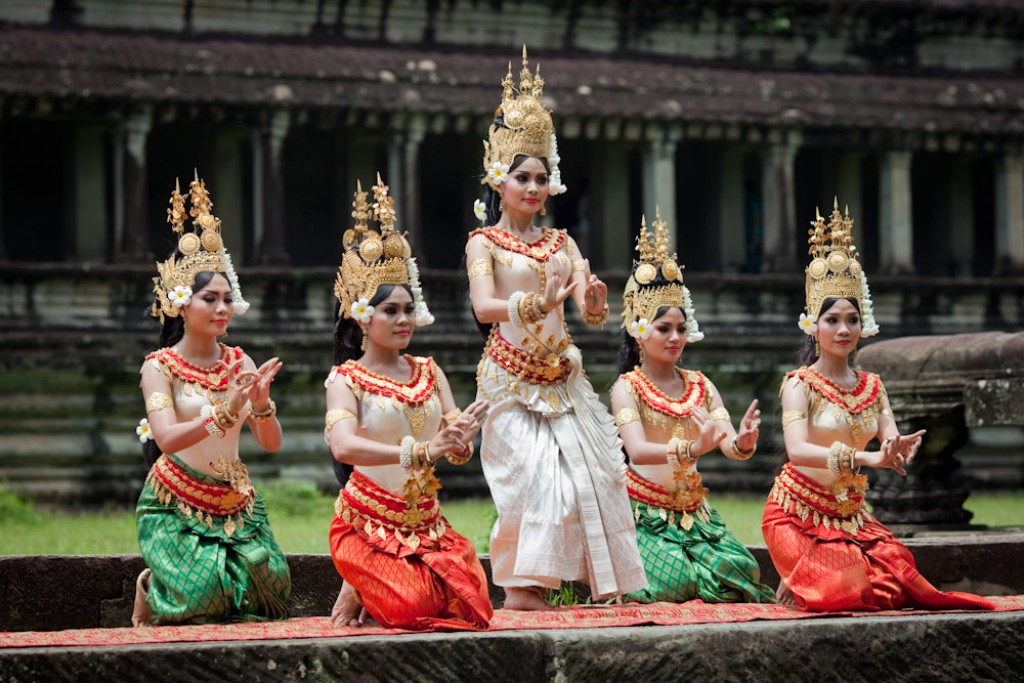Apsara Dance is a graceful and expressive form of Khmer dance that depicts ancient legends and religious tales. The dancers are women (also known as Apsara fairies), who wear tight-fitting traditional costumes and perform intricate movements with their hands and feet. The dance is considered a symbol of Khmer culture and identity, as well as a manifestation of the divine and the sacred.
The History of Apsara Dance
Apsara Dance has its roots in the Angkorian period (9th-15th centuries), when Cambodia was ruled by the powerful Khmer Empire. The empire built many magnificent temples, such as Angkor Wat, Bayon, and Ta Prohm, which are decorated with stone bas-reliefs of apsaras. Apsaras are celestial nymphs or female spirits in Hindu and Buddhist mythology, who are known for their beauty, charm, and dance. They are often depicted as attendants or consorts of gods, such as Indra, Vishnu, and Shiva.
The dance was originally performed by the royal court as a ritual offering to the gods and the ancestors. The dance was also a way of celebrating the glory and prosperity of the empire, as well as entertaining the king and his guests. The dance was highly stylized and codified, with each gesture and posture having a specific meaning and symbolism.
However, the dance declined after the fall of Angkor to the Thai Kingdom of Ayutthaya in the 15th century. The dance was almost lost during the subsequent periods of war, invasion, and colonization. The dance was also suppressed by the Khmer Rouge regime (1975-1979), which tried to eradicate all forms of religion and culture in Cambodia.
The dance was revived in the 20th century by Queen Sisowath Kossomak Nearirath Serey Vatthana, who was inspired by a school performance of apsara dance in paper costumes. She trained her granddaughter, Princess Norodom Buppha Devi, to become the first professional apsara dancer of the modern era. The princess toured the world as the principal dancer of the Royal Ballet of Cambodia, which was established by King Norodom Sihanouk in 1961. The ballet was recognized by UNESCO as an Intangible Cultural Heritage of Humanity in 2008.
The Practice of Apsara Dance
Apsara Dance is performed by a group of female dancers, who wear elaborate costumes and accessories that resemble the apsaras depicted on the Angkorian temples. The costumes consist of a silk brocade skirt (sampot sarabap), a tight-fitting bodice (av bok), a sash (sbai), a collar (kong rak), bracelets (patrum), earrings (kong ngor), anklets (sanlek), and a headdress (mukut). The headdress has three or five points, depending on the rank of the dancer. The costumes are usually in bright colors, such as red, green, blue, yellow, or gold.
The dance is accompanied by a traditional orchestra (pinpeat), which consists of instruments such as gongs (rong vong), xylophones (roneat), flutes (sralai), oboes (sralai thom), drums (sampho), cymbals (chhing), and zithers (takhe). The orchestra plays music that matches the mood and theme of the dance. The music is based on modal scales (pathet) and rhythmic cycles (veang).
The dance consists of various movements that convey different emotions, messages, and stories. The movements are divided into three categories: gestures (kbach), postures (robam), and steps (cham). The gestures are made with the hands and fingers, which can form up to 1,500 different shapes. The postures are made with the body and head, which can express different attitudes and feelings. The steps are made with the feet and legs, which can create different patterns and directions.
The dance is usually performed on a stage or a platform, with a backdrop or a curtain that depicts a scene from the story or legend. The dancers enter and exit from different sides of the stage, depending on their roles and relationships. The dancers do not speak or sing during the performance, but rely on their facial expressions and eye contact to communicate with each other and the audience.
The Symbolism of Apsara Dance
Apsara Dance is not only an artistic expression, but also a spiritual one. The dance is imbued with various meanings and symbols that reflect Khmer culture and beliefs. Some of the symbolism of apsara dance are:
- Apsaras represent beauty, grace, charm, joy, fertility, prosperity, and harmony. They are also seen as messengers and mediators between the human and the divine realms. They can bestow blessings, protection, and inspiration to those who worship them or watch their dance.
- The dance is a form of worship and offering to the gods and the ancestors. The dance is also a way of honoring and preserving the Khmer heritage and identity. The dance is also a way of expressing gratitude and respect to the king and the country.
- The dance is a form of meditation and enlightenment. The dance is also a way of cultivating morality and spirituality. The dance is also a way of achieving nirvana, or liberation from suffering, by following the Buddhist teachings.
List of references:
• [1]: Apsara Dance: The Traditional Khmer Dance by Cambodia Travel
• [2]: Apsara: The Traditional Dance of Cambodia by Cultural Trip
• [3]: Apsara Dance: The Cambodian Classical Dance by Khmer Times
• [4]: Apsara Dance: The Symbol of Khmer Culture by Angkor Focus
• [5]: Apsara Dance: The Intangible Cultural Heritage of Humanity by UNESCO


